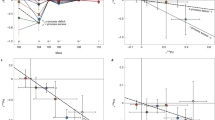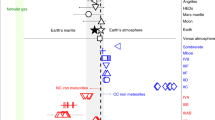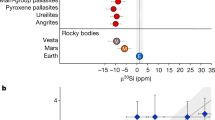Abstract
The origins of the building blocks of the Solar System can be studied using the isotopic composition of early planetary and meteoritic material. Oxygen isotopes in planetary materials show variations at the per cent level that are not related to the mass of the isotopes1,2; rather, they result from the mixture of components having different nucleosynthetic or chemical origins1,2,3. Isotopic variations reaching orders of magnitude in minute meteoritic grains are usually attributed to stellar nucleosynthesis before the birth of the Solar System, whereby different grains were contributed by different stars4,5. Here we report the discovery of abundant silica-rich grains embedded in meteoritic organic matter, having the most extreme 18O/16O and 17O/16O ratios observed (both ∼10-1) together with a solar silicon isotopic composition. Both O and Si isotopes indicate a single nucleosynthetic process. These compositions can be accounted for by one of two processes: a single exotic evolved star seeding the young Solar System6, or irradiation of the circumsolar gas by high energy particles accelerated during an active phase of the young Sun. We favour the latter interpretation, because the observed compositions are usually not expected from nucleosynthetic processes in evolved stars, whereas they are predicted by the selective trapping of irradiation products.
This is a preview of subscription content, access via your institution
Access options
Subscribe to this journal
Receive 51 print issues and online access
$199.00 per year
only $3.90 per issue
Buy this article
- Purchase on Springer Link
- Instant access to full article PDF
Prices may be subject to local taxes which are calculated during checkout



Similar content being viewed by others
References
Clayton, R. N., Grossman, L. & Mayeda, T. K. A component of primitive nuclear composition in carbonaceous meteorites. Science 182, 485–487 (1973)
Clayton, R. N. Oxygen isotopes in meteorites. Annu. Rev. Earth Planet. Sci. 21, 115–149 (1993)
McKeegan, K. D. M. & Leshin, L. A. in Stable Isotope Geochemistry (eds Valley, J. W. & Cole, D. R.) 279–318 (Mineralogical Society of America, Washington, 2001)
Nittler, L. R., Alexander, C. M. O'D., Gao, X., Walker, R. M. & Zinner, E. K. Interstellar oxide grains from the Tieschitz ordinary chondrite. Nature 370, 443–446 (1994)
Clayton, D. D. & Nittler, L. R. Astrophysics with presolar stardust. Annu. Rev. Astron. Astrophys. 42, 39–78 (2004)
Busso, M., Gallino, R. & Wasserburg, G. J. Short-lived nuclei in the early solar system: A low mass stellar source? Publ. Astron. Soc. Austr. 20, 356–370 (2003)
Gardinier, A. et al. Solid state CP/MAS 13C NMR of the insoluble organic matter of the Orgueil and Murchison meteorites: quantitative study. Earth Planet. Sci. Lett. 184, 9–21 (2000)
Zinner, E. et al. Presolar spinel grains from the Murray and Murchison carbonaceous chondrites. Geochim. Cosmochim. Acta 67, 5083–5095 (2003)
Nguyen, A. N. & Zinner, E. Discovery of ancient silicate stardust in a meteorite. Science 303, 1496–1499 (2004)
Nagashima, K., Krot, A. N. & Yurimoto, H. Stardust silicates from primitive meteorites. Nature 428, 921–924 (2004)
Cami, J. & Yamamura, I. Discovery of anomalous oxygen isotopic ratios in HR 4049. Astron. Astrophys. 367, L1–L4 (2001)
Harris, M. J., Lambert, D. L. & Smith, V. V. Oxygen isotopic abundances in evolved stars. I. Six barium stars. Astrophys. J. 292, 620–627 (1985)
Amari, S., Zinner, E. & Lewis, R. S. Large 18O excesses in circumstellar graphite grains from the Murchison meteorite: Indication of a massive-star origin. Astrophys. J. 447, L147–L150 (1995)
José, J., Hernanz, M., Amari, S., Lodders, K. & Zinner, E. The imprint of nova nucleosynthesis in presolar grains. Astrophys. J. 612, 414–428 (2004)
Clayton, G. C. et al. An extremely large excess of 18O in the hydrogen deficient carbon star HD 137613. Astrophys. J. 623, L141–L144 (2005)
Feigelson, E. D., Garmire, G. P. & Pravdo, S. H. Magnetic flaring in the pre-main-sequence sun and implications for the early solar system. Astrophys. J. 572, 335–349 (2002)
Anders, E. & Grevesse, N. Abundances of the elements: Meteoritic and solar. Geochim. Cosmochim. Acta 53, 197–214 (1989)
Reames, D. V. et al. Energy spectra of ions accelerated in impulsive and gradual solar events. Astrophys. J. 483, 515–522 (1997)
Nisini, B., Codella, C., Giannini, T. & Richer, J. S. Observations of high-J SiO emission along the HH221 outflow. Astron. Astrophys. 395, L25–L28 (2002)
McKeegan, K. D., Chaussidon, M. & Robert, F. Incorporation of short-lived 10Be in a calcium-aluminum-rich inclusion from the Allende meteorite. Science 289, 1334–1337 (2000)
Gounelle, M. et al. Extinct radioactivities and protosolar cosmic rays: self-shielding and light elements. Astrophys. J. 548, 1051–1070 (2001)
Caffee, M. W., Hohenberg, C. M., Swindle, T. D. & Goswami, J. N. Evidence in meteorites for an active early sun. Astrophys. J. 313, L31–L35 (1987)
Harris, M. J. & Lambert, D. L. Oxygen isotopic abundances in the atmospheres of seven red giant stars. Astrophys. J. 285, 674–682 (1984)
Harris, M. J., Lambert, D. L. & Smith, V. V. Oxygen isotopic abundances in evolved stars. II. Eight MS and S stars. Astrophys. J. 299, 375–385 (1985)
Dominy, J. F., Wallerstein, G. & Suntzeff, N. B. Abundances of carbon, nitrogen, and oxygen and their isotopes in the atmospheres of four SC stars. Astrophys. J. 300, 325–338 (1986)
Harris, M. J., Lambert, D. L., Hinkle, K. H., Gustafsson, B. & Eriksson, K. Oxygen isotopic abundances in evolved stars. III. 26 Carbon stars. Astrophys. J. 316, 294–304 (1987)
Harris, M. J., Lambert, D. L. & Smith, V. V. Oxygen isotopic abundances in evolved stars. IV. Five K giants. Astrophys. J. 325, 768–775 (1988)
Smith, V. V. & Lambert, D. L. The chemical composition of red giants. III. Further CNO isotopic and s-process abundances in thermally pulsing asymptotic giant branch stars. Astrophys. J. Suppl. 72, 387–416 (1990)
Kahane, C., Cernicharo, J., Gomez-Gonzales, J. & Guélin, M. Isotopic abundances in carbon-rich circumstellar envelopes: a further iteration on the oxygen isotope puzzle. Astron. Astrophys. 256, 235–250 (1992)
Prantzos, N., Aubert, O. & Audouze, J. Evolution of the carbon and oxygen isotopes in the Galaxy. Astron. Astrophys. 309, 760–774 (1996)
Acknowledgements
A. Toppani, J. Kiener, A. Coc, N. Prantzos, M. Gounelle, V. Tatischeff, M. Chaussidon and B. Charoy are thanked for discussions, A. Kohler, B. Assouar, C. Clément and L. Marchal helped with SEM and FESEM, and T. Lhomme helped with the Raman laser. This work was supported by the Région Lorraine, and by PNP-INSU and PCMI-INSU grants.
Author information
Authors and Affiliations
Corresponding author
Ethics declarations
Competing interests
Reprints and permissions information is available at npg.nature.com/reprintsandpermissions. The authors declare no competing financial interests.
Supplementary information
Supplementary Discussion
This file includes a detailed discussion of sample preparation and ion probe analysis, along with a description of the irradiation model used in the calculations. (DOC 37 kb)
Supplementary Data
This Supplementary Table contains all oxygen and silicon data for the samples and reference materials. (DOC 84 kb)
Rights and permissions
About this article
Cite this article
Aléon, J., Robert, F., Duprat, J. et al. Extreme oxygen isotope ratios in the early Solar System. Nature 437, 385–388 (2005). https://doi.org/10.1038/nature03947
Received:
Accepted:
Issue Date:
DOI: https://doi.org/10.1038/nature03947
This article is cited by
-
A Comparison of Presolar Isotopic Signatures in Laboratory-Studied Primitive Solar System Materials and Comet 67P/Churyumov-Gerasimenko: New Insights from Light Elements, Halogens, and Noble Gases
Space Science Reviews (2023)
-
Constraining the Evolutionary History of the Moon and the Inner Solar System: A Case for New Returned Lunar Samples
Space Science Reviews (2019)
-
Presolar Isotopic Signatures in Meteorites and Comets: New Insights from the Rosetta Mission to Comet 67P/Churyumov–Gerasimenko
Space Science Reviews (2018)
-
Extreme oxygen isotope anomaly with a solar origin detected in meteoritic organics
Nature Geoscience (2011)
Comments
By submitting a comment you agree to abide by our Terms and Community Guidelines. If you find something abusive or that does not comply with our terms or guidelines please flag it as inappropriate.



